Holon
Holon (Hebrew: חוֹלוֹן ![]()
Holon
| |
|---|---|
| Hebrew transcription(s) | |
| • ISO 259 | Ḥolon |
Kugel Sokolov Junction Holon | |
 Flag 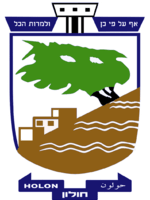 Coat of Arms | |
 Holon 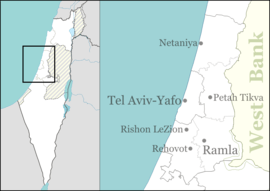 Holon | |
| Coordinates: 32°01′N 34°46′E | |
| Country | |
| District | |
| Founded | 1936 |
| Government | |
| • Type | City (from 1950) |
| • Mayor | Moti Sasson (Labor) |
| Area | |
| • Total | 18,927 dunams (18.927 km2 or 7.308 sq mi) |
| Population (2018)[1] | |
| • Total | 194,273 |
| • Density | 10,000/km2 (27,000/sq mi) |
| Name meaning | (Little) sand |
| Website | holon.muni.il |
Etymology
The name of the city comes from the Hebrew word חוֹלוֹן holon, meaning "(little) sand". The name Holon also appears in the Bible: "And Holon with its suburbs, and Debir with its suburbs" (Book of Joshua, 21:15).[2]
History
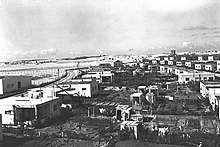
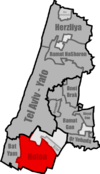
Holon was founded on sand dunes six kilometers (3.7 miles) from Tel Aviv in 1935.[3] The Łódzia textile factory was established there by Jewish immigrants from Łódź, Poland, along with many other industrial enterprises.[3] In the early months of the 1948 Arab–Israeli War, Holon was on the front line, with constant shooting taking place on the border with the village of Tel A-Rish to its northwest—a suburb of Arab Jaffa—and clashes also in the direction of the town of Yazur to the east. An attack by the Holon-based Haganah militia units on Tel A-Rish was repulsed with considerable losses.
After the establishment of the state, Holon expanded to include Tel A-Rish (renamed "Tel Giborim", "The Mound of the Heroes") and the orange groves of Yazur.
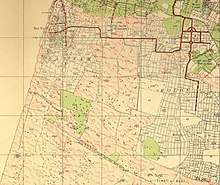

In February 2001, eight Israelis were killed and twenty-five were injured in a Palestinian attack on a crowded bus stop in Holon.[4]
The image of Holon as a working-class bedroom community has changed over the years. Through municipal efforts, the city has been rebranded as a child-friendly city, offering family attractions such as the Yamit Water Park, the Israeli Children's Museum and the Israel Museum of Caricature and Comics.[5]
Urban development
Historic landmarks in Holon slated for preservation include Derech Habitachon ("Safe Road"), paved during the Israeli war of independence; water towers in the Moledet and Azor neighborhoods; Hosmasa, a building used by the Haganah; the pillbox guard post; Stroma Square, Mansbach health clinic, Hameshakem building, the Agrobank neighborhood and two schools – Bialik and Shenkar.[6] A new neighborhood, Migdalim Bashdera, is under construction, with plans for 23 upscale residential towers, a new city hall, several cultural and commercial centers, some of them already built. A French urban planner was commissioned to design a north-south boulevard with pedestrian walks, bicycle paths, sports fields, parks and waterfalls.[5] The last undeveloped land reserve remaining in Holon is the H-500 Holon plan, that consists of approximately 4,080 dunams in the south of the city, and is intended to consist of 13,700 dwelling units in total.[7]
Local government
Mayors
- Haim Kugel – 1940 to 1953[8]
- Pinhas Eylon – 1953 to 1987[8][9]
- Haim Sharon – 1987 to 1988
- Moshe Rom – 1988 to 1993
- Moti Sasson – 1993 to present
Culture
Holon hosts a variety of springtime events, including the Yemay Zemer (Days of Song) Festival during Passover and a Women's Festival in March, both at the Holon Theater. Holon is also one of the host cities for the Rhythmic Gymnastics Grand Prix Series in March.[10] Israeli violinist Pinchas Zukerman runs a summer music camp in the city for young violinists.[11] Since the election of Mayor Moti Sasson in 1993, many cultural projects have been inaugurated. Billing itself as a "children's city," Holon is home to the Holon Children's Museum and the Mediatheque youth theater.[12] Holon also plays host each year to a street carnival in celebration of the Jewish holiday of Purim, the Adloyada. Thousands of children dress up in costumes and the streets close down for a parade featuring colorful floats.[13]
The Design Museum Holon, which opened in 2010 near the "Médiathèque" and the Faculty of Design of Holon Institute of Technology, is the first Israeli museum of design.
In October 2013, Holon hosted major international designers who arrived for Holon Fashion Week (known as HoF13), among them milliner Stephen Jones and BioCouture founder Suzanne Lee.[14]
Cinematheque Holon hosts the only digital arts and media arts festival in Israel, Print Screen Festival.[15] The festival was established 2010.
Samaritan community
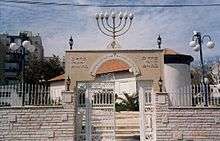
In 1954, the president of Israel, Yitzhak Ben-Zvi, helped to establish a Samaritan quarter on the outskirts of Holon. The quarter was named Neve Pinchas after Pinhas Ben-Abraham, the high priest of the Samaritan community.[16]
Holon is one of only two cities in the world to have a Samaritan community, the other being the village of Kiryat Luza on Mount Gerizim above Nablus on the West Bank.
Education
The Collège-Lycée franco-israélien Raymond Leven is located in Mikve, Holon.[17]
Sports
- Hapoel Holon (basketball) – premier league, national champion in 2008 and state cup holder in 2009
- Hapoel Tzafririm Holon F.C. (football) – Liga Alef [3rd tier]
Notable residents
- Moshik Afia (born 1974), singer
- Chen Aharoni (born 1990), singer
- Oz Almog (born 1956), Israeli-Austrian artist & author
- Rafi Amit, poker player
- Avraam Benaroya (1953–1979), Greek-Jewish socialist leader, founder of the Communist Party of Greece
- David Ben Dayan (born 1978), football player
- Omri Casspi (born 1988), NBA basketball player (Golden State Warriors)
- Bat-Sheva Dagan (born 1925), Holocaust survivor, teacher, psychologist, author
- David D'Or (born 1966), countertenor & composer; Israel's 2001 Singer of the Year
- Ilona Feher (1949–1988), violinist
- Dana International (born 1972), pop singer
- Tomer Kapon (born 1985), film and television actor
- Hila Klein (born 1987), YouTuber
- Eran Kolirin (born 1973), cinema director & script writer
- Aryeh Krishek (born 1952), novelist and biographer
- Sofia Mechetner (born 2000), model, the face of Dior
- Moran Mazor (born 1991), singer
- Avihu Medina (born 1948), composer, arranger, songwriter, and singer
- Adir Miller (born 1974), actor, screenwriter and comedian
- Moshe Mizrahi (born 1980), Israeli basketball player
- Lior Narkis (born 1976), singer
- Chen Reiss (born 1979), opera singer
- Shira Rishony (born 1991), Olympic judoka
- Peter Roth (born 1974), rock singer & composer
- Ben Sahar (born 1989), football player
- Arie Vardi (born 1937), pianist & teacher
- Rahel Vigdozchik (born 1989), Olympic rhythmic gymnast
- Avraham Yosef (born 1949), rabbi and son of Ovadia Yosef
- Rami Yosifov (born 1966), guitarist of Teapacks
Twin towns – sister cities
Holon is twinned with:[18][19]







Gallery
 Convoy being assembled at Holon, 1948
Convoy being assembled at Holon, 1948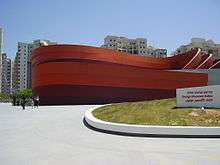
 Yanshul, symbol of the Holon Children's Museum
Yanshul, symbol of the Holon Children's Museum
References
- "Population in the Localities 2018" (XLS). Israel Central Bureau of Statistics. August 25, 2019. Retrieved August 26, 2019.
- "The Story of Holon:Making Sand Dunes Sophisticated". Isrealli.org. Archived from the original on February 28, 2011. Retrieved January 20, 2011.
- The Guide to Israel, Zeev Vilnay, Hamakor Press, Jerusalem, 1972, p.239
- "Victims of Palestinian Violence and Terrorism since September 2000". Mfa.gov.il. Archived from the original on April 3, 2007. Retrieved April 25, 2014.
- Bassok, Moti (November 29, 2013). "Working class Holon aims to attract affluent home buyers". Haaretz. Retrieved April 25, 2014.
- Aderet, Ofer (June 9, 2011). "Holon seeking to preserve 18 historic sites". Haaretz. Retrieved April 25, 2014.
- "The Holon H-500 Information Arena". Joseph Raiten. Retrieved December 27, 2016.
- "Haim Kugel". Holon City. Retrieved June 8, 2015.
- "Pinhas Eylon". Holon City. Retrieved June 8, 2015.
- "Festivals". Holon Municipality. Retrieved May 8, 2013.
- "Israeli cultural scene explodes with dynamic music, fiction, art". Jweekly. June 5, 1998. Retrieved April 25, 2014.
- "Post-championship Holon dreams of prosperity, tourism – Haaretz – Israel News". Haaretz. Retrieved May 5, 2009.
- Purim parade in Holon, Jerusalem Post
- Handwerker, Haim (September 10, 2013). "Holon Fashion Week attracts big industry names". Haaretz. Retrieved April 25, 2014.
- Print Screen Festival, official homepage
- "Samaritans". Jewishmag.com. Retrieved May 5, 2009.
- "La localisation." Collège-Lycée franco-israélien Raymond Leven. Retrieved on January 22, 2015. "Agricultural School Mikve Israel Mikve israel street 1 5891000 Holon – ISRAEL" – Address in Hebrew: "בה"ס חקלאי מקווה ישראל 5891000 חולון"
- "International relations". holon.muni.il. Holon. Retrieved February 24, 2020.
- "Cleveland's Sister Cities". city.cleveland.oh.us. City of Cleveland. Retrieved February 24, 2020.
External links
| Wikimedia Commons has media related to Holon. |
| Wikimedia Commons has media related to Holon Cemetery. |
| Wikivoyage has a travel guide for Holon. |
- Holon Municipality official site (English)
- Friends of Holon Foundation (English)
- Design Museum Holon (English)
- Hapoel Holon Basketball Club official site (Hebrew)
- Holon's Story Gardens (1/2)
- Holon's Story Gardens (2/2)
- Youth week in Holon (Hebrew)
- City blog presents the best part of the Holon city (Hebrew)
- The Holon H-500 Information Arena (English and Hebrew)
- Pictures of Holon Design Museum(English)